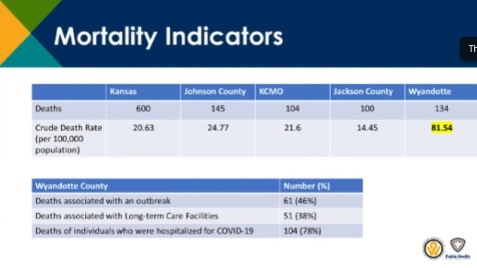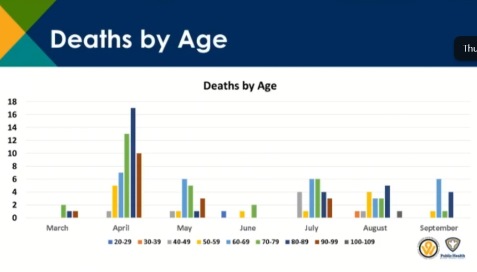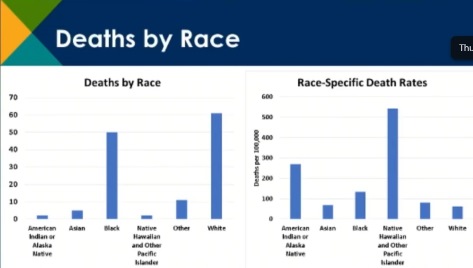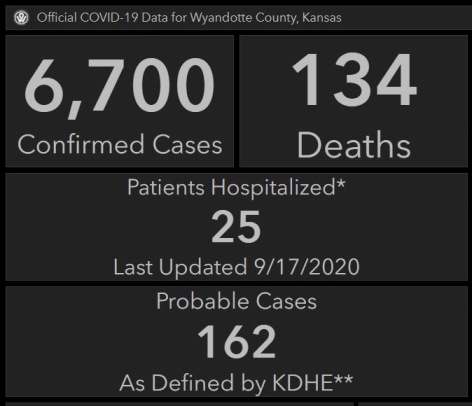COVID-19 mortality rate in Wyandotte County far surpasses surrounding area




COVID-19 mortality rates in Wyandotte County are much higher than surrounding communities, according to health officials.
Juliann Van Liew, director of the Unified Government Health Department, said that Wyandotte County’s death rate is five times higher than eastern Jackson County, and four times higher than Kansas City, Missouri, and Johnson County. She made her remarks at a Thursday news conference sponsored by the University of Kansas Health System.
The Health Department uses the death rate per 100,000 population for comparison.
“What it shows is folks in Wyandotte County are dying at much higher rates than folks in surrounding communities,” Van Liew said.
Deaths associated with an outbreak make up almost half of the total in Wyandotte County, while deaths associated with long-term care facilities made up 38 percent, she said.
Of the total deaths in Wyandotte County from COVID-19, currently at 134, almost 80 percent of them had been hospitalized, according to Van Liew. There were some deaths of individuals with COVID-19 who were not hospitalized, according to the data.
Deaths have been throughout the county, Van Liew said. There have been a total of 134 deaths.
Most deaths have been in the age 60 to 100 population, she said.
In April, they had the greatest number of deaths in the county, with many age groups, she said. In July and August, younger populations were showing increases in the death rates.
By race, deaths in Wyandotte County have been highest among whites, with 62, and blacks, with 50.
Even more important are the rates, she said.
Per 100,000, they are seeing higher rates of American Indian, Hawaiian and Pacific Islander, she said. Because they are very small populations in the county, even a handful of deaths mean that the rate is high.
The black death rate is significantly higher here than the white rate, due to the proportion of blacks to whites in the community, she added. The rates were compiled per 100,000.
There was a lower number of Hispanic deaths compared to non-Hispanics, she said. The non-Hispanic rate was higher, but the Hispanic rate has started to increase in recent months, she said.
Van Liew said they are seeing disparities here because there are poorer baseline health outcomes here, higher rates of cancer, hypertension and disabilities, and other comorbidities. There are also higher rates of comorbidities in the black and Hispanic communities, she said.
Other drivers are economics and industries, with the major industries here packaging, manufacturing, transportation and health care, she said. All are sectors where people can’t stay home but have to go to work where they may have close contact with others, and that is a factor, also.
Other barriers to receiving care include language and cost. That means people may get care later than they otherwise would have, and that plays into the mortality rate as well, she said.
Patrick Sallee, CEO of Vibrant Health, said they are testing four to five times a week across the community. Recently the criteria changed to include asymptomatic testing, he said.
At Vibrant Health, they saw a busy month with back-to-school physicals, he said.
“Lately, we are starting to see calls from patients whose children are in school and have had an exposure or have had symptoms,” Sallee said. “There’s a little bit of a spike in concern or testing for kids back in school, so it’s a little bit concerning for where we’re headed in the next few weeks.”
Dr. Dana Hawkinson, medical director of infection control and prevention at the University of Kansas Health System, said in metropolitan Kansas City, they were down to 260 cases a day a week or two ago, but now are up to around 300 cases a day, showing an increase recently.
Van Liew recommended wearing masks, social distancing and the other health measures.
“Right now we are very concerned about the school situation,” Van Liew said. “We’ve had very good partnerships with schools and school nurses. We currently have about seven classes on quarantine in the Wyandotte County community right now.”
She asked parents to keep their kids home if they have any symptoms, so they can keep the rest of the kids safe.
Van Liew said the testing numbers have been down in Wyandotte County, and it has been hard to identify positive people without tests, so the Health Department has changed to asymptomatic testing, available five days a week.
She said they will have saliva testing available soon, and will test at all schools at the county, as well as at the jail and behavioral facilities.
Dr. Hawkinson said 21 COVID-19 patients were at KU Health System on Thursday morning, down from 26 on Wednesday. Eight were in the intensive care unit, a decrease of one from Wednesday, and two were on ventilators, a decrease of one from Wednesday. There were 23 additional COVID-19 patients at KU Health System who were no longer in the acute infection stage. Hays (Kansas) Medical Center reported 17 COVID-19 inpatients, with 15 acute cases and two in recovery.
Wyandotte County reported an additional 47 COVID-19 cases on Thursday, for a cumulative total of 6,700 cases, according to the Unified Government COVID-19 webpage. There were no additional deaths reported, with the same cumulative total of 134 as on Wednesday.
Free testing continues Friday
Free testing will be open from 9 a.m. to 3 p.m. Monday through Friday at the Health Department parking lot, 619 Ann Ave., Kansas City, Kansas. People should bring an item such as a piece of mail or a work badge to show they live or work in Wyandotte County.
The pop-up tests and the Health Department tests now are open to asymptomatic people as well as those who have symptoms or have been exposed to COVID-19. Check with the UG Health Department’s Facebook page to see if there have been any changes in the schedule.
More information about testing is at https://wyandotte-county-covid-19-hub-unifiedgov.hub.arcgis.com/pages/what-to-do-if-you-think-you-have-covid-19, or call 311.
The KU doctors’ news conference is at https://www.facebook.com/kuhospital/videos/248053009904322.
The UG COVID-19 webpage is at https://alpha.wycokck.org/Coronavirus-COVID-19-Information.
The Unified Government COVID-19 hub outbreak map at https://wyandotte-county-covid-19-hub-unifiedgov.hub.arcgis.com/.
To see an NEA list of schools that have had COVID-19 cases, visit https://app.smartsheet.com/b/publish?EQBCT=aa3f2ede7cb2415db943fdaf45866d2f.
The KC Region COVID-19 Hub dashboard is at https://marc2.org/covidhub/.
The Unified Government Health Department is collecting input on people’s experiences getting tested for COVID-19 in Wyandotte County. The survey is on the UG website at https://us.openforms.com/Form/ea97a450-3d74-4d86-8d1f-6e340d55cf7c.
The UG Health Department school and sports guidance is online at https://alpha.wycokck.org/files/assets/public/health/documents/covid/09042020fallsportsrecommendations.pdf.
A previous UG sports order is online at https://alpha.wycokck.org/files/assets/public/health/documents/covid/08132020localhealthofficerorderregardingsports.pdf.
The Wyandotte County school start order is online at https://alpha.wycokck.org/Coronavirus-COVID-19-Information.
Wyandotte County is under a mandatory mask order and is in Phase 3 of the state’s reopening plan. For more information, residents may visit the UG COVID-19 website at https://alpha.wycokck.org/Coronavirus-COVID-19-Information or call 311 for more information.
The KDHE’s COVID-19 webpage is at https://www.coronavirus.kdheks.gov/.
The CDC’s COVID-19 webpage is at https://www.cdc.gov/coronavirus/2019-nCoV/index.html.
